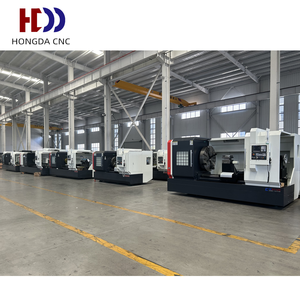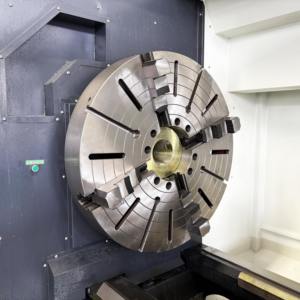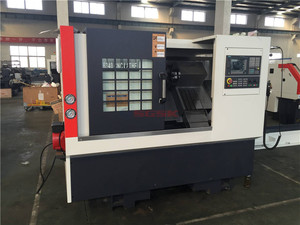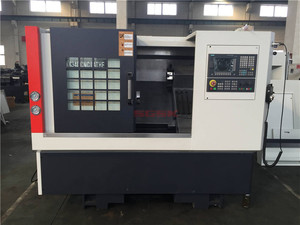
All categories
Featured selections
Trade Assurance
Buyer Central
Help Center
Get the app
Become a supplier

(1033 products available)



























A multi-purpose CNC (Computer Numerical Control) lathe machine allows the automated execution of various machining processes on a workpiece. These machines commonly have multiple heads or attachments to enable different machining tasks without needing workpiece transfers or setups. Here are some types:
Multipurpose CNC Lathe with Attachments:
Various attachments expand the capabilities of a standard CNC lathe machine. Some standard attachments include a CNC lathe milling machine attachment, a CNC lathe metal cutting band saw attachment, a CNC cutting torch attachment, and many more. These attachments transform a standard CNC lathe into a multipurpose machining center that can carry out various machining processes on a workpiece.
Multipurpose CNC Combined Machines:
Combined multipurpose CNC machines integrate two or more standard machining processes into a single workstation. For example, a CNC turn-mill machine combines CNC milling and lathe machining capabilities in one machine. The integrated design eliminates the need for multiple machines or workstations, reducing setup times and improving production efficiency. Some other typical combined multipurpose CNC machines include the CNC lathe with a plasma cutter, the CNC router with a milling head, and more.
Multipurpose CNC Machines with Rotating Heads:
CNC machines with rotating heads feature an interchangeable or programmable head that can rotate. The rotating head can be transformed to perform several machining tasks, such as drilling, tapping, threading, countersinking, etc. These machines have high efficiency, precision, and flexibility in processing workpieces with different materials and shapes.
Overall, the main benefit of a multi-purpose CNC machine tool is to streamline machining processes, reduce setup times, and improve precision and efficiency in production. These machines are ideal for high-production manufacturing environments that require rapid turnaround and tight tolerances.
Due to their many functions and accurate machining capabilities, multi-purpose CNC lathes have many applications in various industries.
Manufacturing industry
CNC lathes are widely used in the manufacturing industry. They can be used to process a variety of materials, such as metals, plastics, and wood, to make workpieces of various shapes and sizes. For example, they can make cylindrical parts like shafts and pipes, as well as complex contoured parts like gears and threads.
Aerospace field
In the aerospace field, multi-purpose CNC lathes play a vital role. They machine precise and high-strength parts such as turbine blades, structural components, and engine parts. These parts usually require lightweight, high strength, and heat resistance, among other features. Also, the machining process requires great precision and high automation.
Automotive industry
In the automotive industry, multi-purpose CNC lathes are widely used to manufacture various parts of vehicles. They machine parts such as engines, gearboxes, and chassis. Multi-purpose CNC lathes can process complex shapes and ensure high precision and consistency required for automotive parts by utilizing their functions such as idle speed, thread cutting, and grooving.
Electronic products
Multi-purpose CNC lathes are also key tools in the electronics industry. They are used to manufacture precision electronic components such as connectors, switches, and housings. These components require small size, intricate shapes, and tight tolerances that are difficult to achieve through traditional machining methods.
Medical device manufacturing
Multi-purpose CNC lathes are also widely used in the medical device manufacturing industry, such as medical instruments and implants. This includes precision machining of complex shapes and tight tolerances required for medical devices, ensuring compliance with strict industry standards.
When choosing a CNC lathe machine for sale, it is important to create a comprehensive checklist of things that will influence the purchasing decision. This checklist helps to define the use cases and specifications for the ideal machine to buy.
When creating the list, it helps to bring in the intended audience for the CNC machine. Will it be used for custom projects or in an industrial workshop? If it is meant for an industrial workshop, a large centerpiece with automatic features will be perfect. If it is used for custom projects, small portable devices will suffice.
Next, determine the type of material the lathe will work on. The devices work on different types of materials, so buyers need to be clear about the material they will use the machine to shape. Knowing the type of material will help buyers choose a device compatible with the substance in question. This applies to the device’s construction features, such as the clamping mechanism and cutting tools.
Another important part of the checklist is the required workpiece size and weight capacity. The lathe device has different sizes and weights. The size and weight capacity of the intended machine will determine its size and weight capacity. Most full-sized CNC lathe machines can take up to 400 mm of diameter.
Be clear about the desired level of automation of the CNC machine in question. Some devices have automatic feeding, while others have it manually fed. Determine the level of automation before buying, as it will determine the cut’s accuracy and repeatability of the devices with higher automation functions.
Finally, determine the budget before purchasing a device. CNC machines with more advanced and automated features cost a lot more than those with less advanced features. Know what needs to be spent and the type of device that has to be bought to serve its purpose.
Q: What can a CNC lathe do?
A: CNC lathes are versatile machines that can perform various tasks. Some of the most common applications include boring, facing, external grooving, turning, internal threading, knurling, tapping and threading, facing and milling. Advanced lathes can also do more complex jobs like orbital and vibratory machining, welding, off-axis machining, and heater barrel extraction.
Q: What parts of an object can a CNC lathe not reach?
A: CNC lathes work well on spherical and cylindrical objects. The internal parts they cannot access include corroded areas, internal threads, undercuts, blind holes, and tight voids.
Q: What type of multi-purpose CNC lathe is popular?
A: The horizontal type is the most common CNC lathe. It has a work table that supports workpieces in a horizontal position. Other typical types are the vertical, mini, and new energy CNC lathes. Multi-axis horizontal lathes handle more complex tasks with less manual intervention.